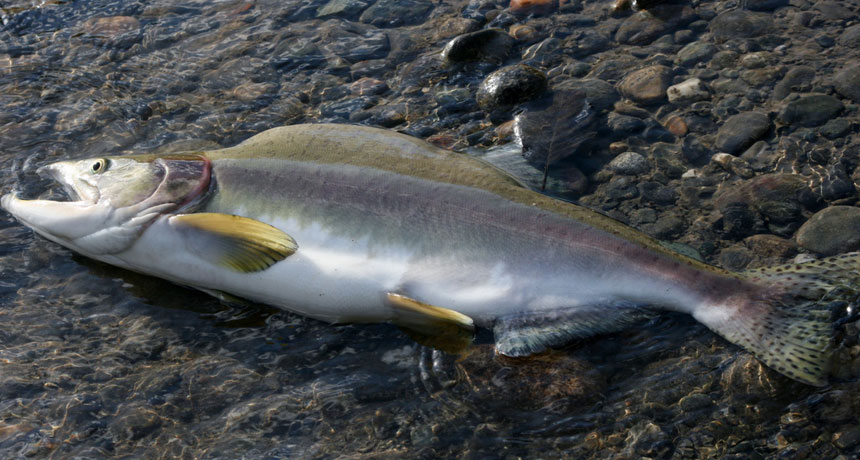Pink salmon threatened by freshwater acidification

Adult male pink salmon develop a hump on their back during their spawning migration. New research indicates that, under higher levels of atmospheric carbon, fewer fish may reach this stage of life.
Brent M./Flickr (CC-BY-NC-SA 2.0)
- More than 2 years ago
As carbon dioxide levels in the atmosphere rise, the world’s oceans are absorbing some of the gas and slowly becoming more acidic. That acidification impedes the chemical reaction that many marine species use to make calcium carbonate shells and skeletons. Fish were once thought to be immune to the drop in pH, but a growing amount of evidence show that these species, too, are affected. Now comes evidence that acidification might be a problem for freshwater fish as well.
Only 0.8 percent of the world’s water is freshwater, but 40 percent of the world’s fish species live in those ecosystems. Then there are fish, like salmon, that spend part of their lives in freshwater and part in the oceans — and are often a concern because they are not only key to ecosystems but also are important because we eat a lot of them.
Michelle Ou of the University of British Columbia in Vancouver and colleagues looked at one of those species, pink salmon (Oncorhynchus gorbuscha) from the U.S. Pacific coast. This are a common species of salmon, and one that lives quickly. The fish hatch in freshwater streams, hang out there for about a month, and then swim downstream to the ocean. In less than two years, they’re back at their natal spot for spawning and death.
Ou’s team let salmon hatch in waters that had ambient or elevated levels of carbon dioxide similar to what is projected for the future. Another group was exposed to conditions of varying carbon dioxide, similar to what’s found in some streams. The researchers then tested the fish as they grew up and eventually were transferred to saltwater.
The young salmon grew more slowly, and they had difficulty detecting alarm cues and amino acids. The amino acids are a worry because scientists think these molecules play a role in how salmon identify their natal streams. The fish were also less anxious and bolder, which could make them more vulnerable to predators. And the problems continued when they were transferred to seawater; their growth and metabolism were affected.
None of these effects was enough to kill the fish outright, but together, the changes in physiology and behavior might be enough to threaten the salmon population, the researchers report June 29 in Nature Climate Change.
“Salmon have enormous cultural significance in the northern Pacific, they support commercial and recreational fisheries, and they are fundamental to the function and productivity of coastal ecosystems,” notes Philip Munday of James Cook University in Townsville, Australia, in an accompanying commentary. “Consequently, any effects of elevated CO2 on the growth and survival of juvenile salmon could have far-reaching ecological, economic and social consequences.”







